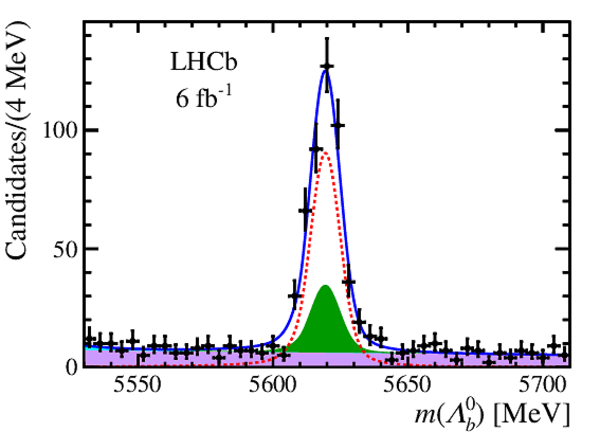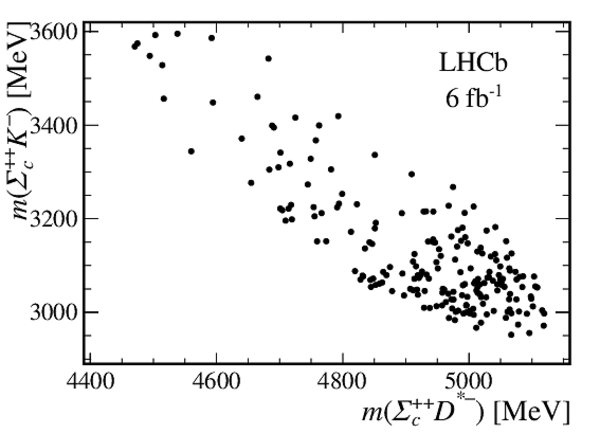First observation of $Λ_{b}^{0} \rightarrow Σ_c^{(*)++} D^{(*)-} K^{-}$ decays
[to restricted-access page]Information
LHCb-PAPER-2023-044
CERN-EP-2024-098
arXiv:2404.19510 [PDF]
(Submitted on 30 Apr 2024)
PRD Lett
Inspire 2782247
Tools
Abstract
The four decays, $\Lambda_{b}^{0} \rightarrow \Sigma_c^{(*)++} D^{(*)-} K^{-}$, are observed for the first time using proton-proton collision data collected with the LHCb detector at a centre-of-mass energy of $13 \rm{TeV}$, corresponding to an integrated luminosity of $6 \rm{fb}^{-1}$. By considering the $\Lambda_b^0 \rightarrow \Lambda_c^{+} \overline{D}^0 K^{-}$ decay as reference channel, the following branching fraction ratios are measured to be, $$\frac{\cal{B} (\Lambda_{b}^{0} \rightarrow \Sigma_{c}^{++} \rm{D}^{-} {K}^{-})}{\cal{B}(\Lambda_{b}^{0} \rightarrow \Lambda_c^{+} \rm \overline{D}^0 {K}^{-})} = {0.282}\pm{0.016}\pm{0.016}\pm{0.005}, \frac{\cal{B}(\Lambda_{b}^{0} \rightarrow \Sigma_{c}^{*++} \rm {D}^{-} {K}^{-})}{\cal{B}(\Lambda_{b}^{0} \rightarrow \Sigma_c^{++} \rm {D}^{-} {K}^{-})} = {0.460}\pm{0.052}\pm{0.028}, \frac{\cal{B}(\Lambda_{b}^{0} \rightarrow \Sigma_{c}^{++} \rm {D}^{*-} {K}^{-})}{\cal{B}(\Lambda_{b}^{0} \rightarrow \Sigma_c^{++} \rm {D}^{-} {K}^{-})} = {2.261}\pm{0.202}\pm{0.129}\pm{0.046}, \frac{\cal{B}(\Lambda_{b}^{0} \rightarrow \Sigma_{c}^{*++} \rm D^{*-} K^{-})}{\cal{B}(\Lambda_{b}^{0} \rightarrow \Sigma_c^{++} \rm D^{-} K^{-})} = {0.896}\pm{0.137}\pm{0.066}\pm{0.018},$$ where the first uncertainties are statistical, the second are systematic, and the third are due to uncertainties in the branching fractions of intermediate particle decays. These initial observations mark the beginning of pentaquark searches in these modes, with more data set to become available following the LHCb upgrade.
Figures and captions
|
Feynman diagrams for (left) color-suppressed and (right) color-favored tree processes of the $\Lambda ^0_ b $ baryon decaying into $\Sigma_{c}^{(*)} \overline{ D } {}^{(*)} K ^- $ or $\Lambda ^+_ c \overline{ D } {}^{(*)0} K ^- $. |
Fig_1.pdf [62 KiB] HiDef png [29 KiB] Thumbnail [14 KiB] *.C file tex code |

|
|
Two-dimensional invariant mass fits of the $\Lambda ^0_ b \rightarrow \Sigma_c^{(*)++} D ^- K ^- $ decay, projected onto (top left) $m_{\Lambda ^+_ c \pi ^+ }$ and (top right) $m_{\Lambda ^+_ c D ^- K ^- \pi ^+ }$. A similar fit to $\Lambda ^0_ b \rightarrow \Sigma_c^{(*)++} D ^{*-} K ^- $ decay is projected onto (bottom left) $m_{\Lambda ^+_ c \pi ^+ }$ and (bottom right) $m_{\Lambda ^+_ c D ^{*-} K ^- \pi ^+ }$. The two signal contributions with resonant $\Sigma ^{++}_ c $ and $\Sigma ^{*++}_ c $ are drawn as a single component (red dashed line). Similarly, the two resonant $\Sigma_c^{(*)++}$ backgrounds without $\Lambda ^0_ b $ peaks are drawn together (cyan fill). |
Sigmac_M.pdf [35 KiB] HiDef png [305 KiB] Thumbnail [240 KiB] *.C file |

|
|
Lb_PVF[..].pdf [25 KiB] HiDef png [230 KiB] Thumbnail [175 KiB] *.C file |

|
|
|
Lb_PVF[..].pdf [22 KiB] HiDef png [223 KiB] Thumbnail [166 KiB] *.C file |

|
|
|
Animated gif made out of all figures. |
PAPER-2023-044.gif Thumbnail |

|
Tables and captions
|
Summary of systematic uncertainties. The correlation between those due to the limited statistics of simulated samples and other sources is considered. Systematics uncertainties due to the modeling of track reconstruction and trigger efficiencies are assumed to cancel out in the ratios between signal modes. |
Table_1.pdf [95 KiB] HiDef png [74 KiB] Thumbnail [27 KiB] tex code |

|
Supplementary Material [file]
Created on 17 May 2024.





